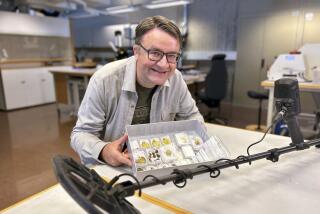Study casts doubt on Neanderthals’ use of tools
- Share via
Scientists have argued over Neanderthals’ intelligence: Were they smart enough to develop complex tools on their own, or did they pick up the habit from modern humans? A new study says that debate may be moot — the tools and trinkets credited to Neanderthals may not be Neanderthal at all.
European researchers used a sophisticated carbon-dating technique to test a hyena-tooth pendant, a reindeer-bone awl and other artifacts found in a French cave alongside Neanderthal remains. They discovered that some of the items were as young as 21,000 to 23,000 years old — too young to have belonged to Neanderthals, who died out about 25,000 years ago.
The provenance of these artifacts has been “bitterly debated over more than 20 years,” said Oxford University radiocarbon specialist Thomas Higham, who led the study published online Monday in Proceedings of the National Academy of Sciences. “It’s quite important because this is at the heart of the cognitive ability of modern Neanderthals and whether they were on par with humans.”
The debate centers on Grotte du Renne, a site in central France where tools and ornaments were discovered in the same layers of dirt as Neanderthal remains.
It is rare to find the two together. The artifacts, which are more commonly associated with modern humans, have been found side by side at only one other location, a French cave called Quincay, Higham said. Their appearance in the same layer of earth suggests to archaeologists that they were buried — and thus existed — during the same time period.
But Higham’s team argues that layers of soil closer to the surface — younger layers containing human remains and artifacts — could have been mixed with deeper layers that held Neanderthal remnants.
Other researchers had proposed that Neanderthal bones and human artifacts were mixed together at Grotte du Renne, and Higham wanted to test that theory by using a more refined carbon-dating technique to ascertain the age of the items. Among other improvements, the team employed a process called ultrafiltration to separate small amounts of bone collagen from material that would pollute the samples.
Higham’s team found that for many samples, the age of the items didn’t correspond with the depth at which they were discovered. For example, in the eighth level down, specimens were dated between 35,000 and 40,000 years old. But two layers below, where all samples should have been older, they found a horse-bone awl that was only 21,150 years old.
“We suggest it might be a good idea to set this site to one side for a bit,” Higham said, “because for the moment, to us, it looks like the site is mixed.”
But Jean-Jacques Hublin, a paleoanthropologist at the Max Planck Institute for Evolutionary Anthropology in Leipzig, Germany, said the site could not be dismissed so easily.
“I agree that we should be cautious, but caution does not mean we should reject all the evidence,” said Hublin, who was not involved with the study.
He said the topic was sensitive because many people had a natural tendency to see Neanderthals as completely different from later humans — even though much evidence shows they were actually quite similar, able to adapt and innovate much as humans do. For example, a study in the Journal of Archaeological Method and Theory last month argued that Neanderthals developed new weapons to hunt smaller game as the climate grew arid and larger prey became scarce.
Hublin also pointed out that Higham’s team wasn’t able to calculate ages for the Neanderthal bodies found at Grotte du Renne, because the tooth and bone samples required for the analysis would be destroyed during the carbon-dating process. Perhaps the Neanderthal remains would have registered as the same age as the disputed artifacts, he said.
“The only way to address these questions is to directly date the [Neanderthal] remains,” Hublin said.







